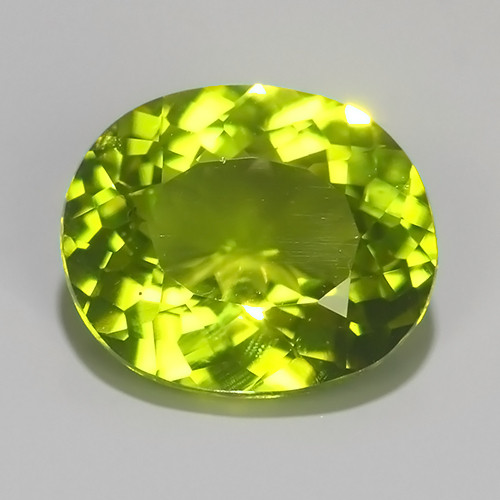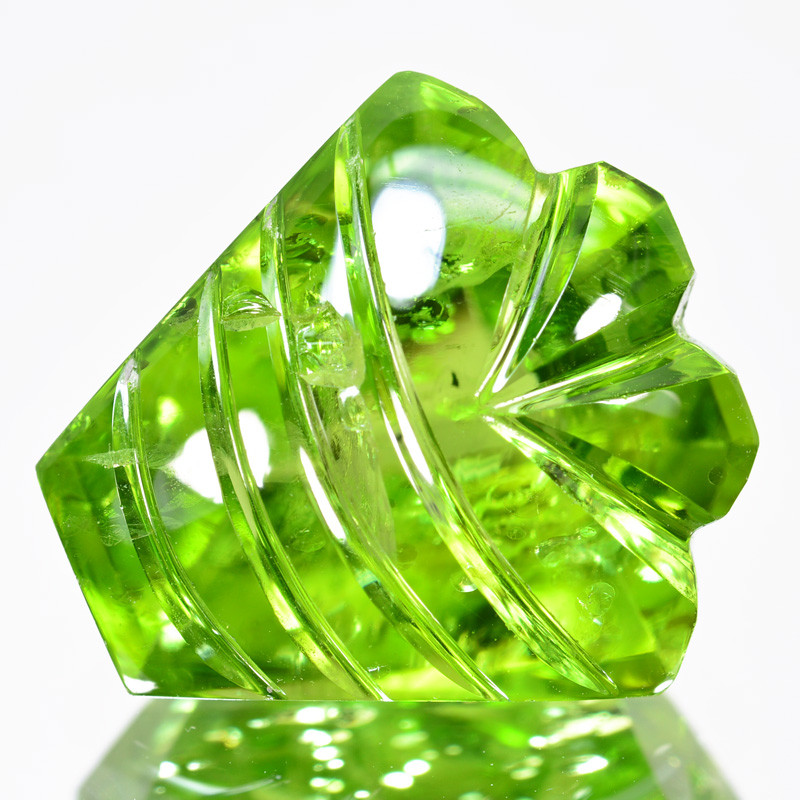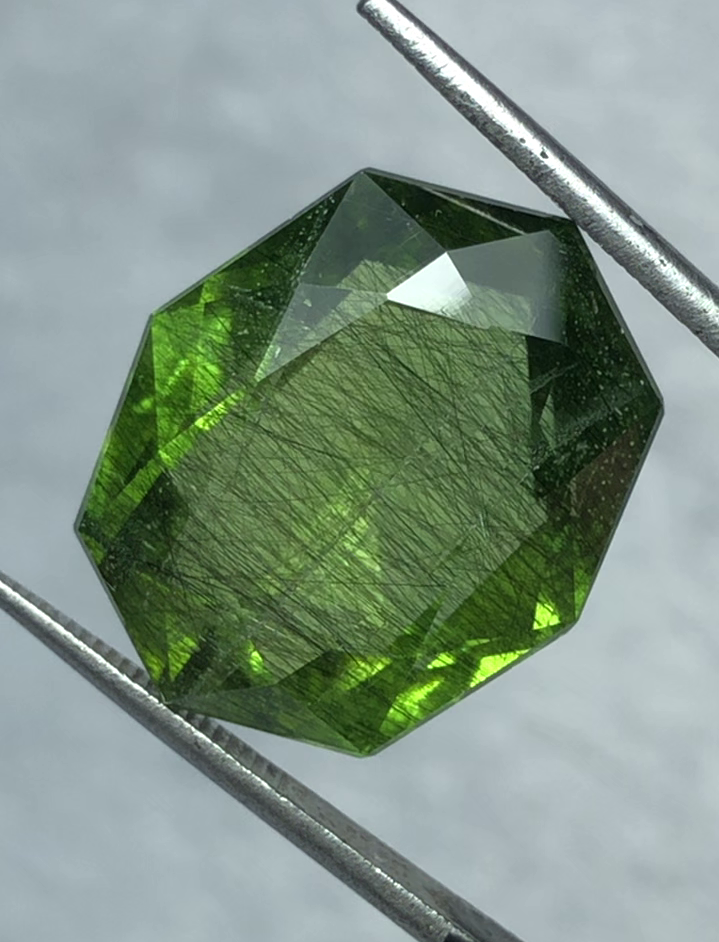
Peridot Stone Meaning, Uses, Properties, Value, & More
 Peridot has captivated jewelers and healers over time with its striking shades of green and yellow, not to mention its rich history dating back to Ancient Egypt. Artifacts made with peridot crystal have been uncovered for centuries throughout many cultures, and it continues to be used to this day. What’s the scoop on the peridot stone?
Peridot has captivated jewelers and healers over time with its striking shades of green and yellow, not to mention its rich history dating back to Ancient Egypt. Artifacts made with peridot crystal have been uncovered for centuries throughout many cultures, and it continues to be used to this day. What’s the scoop on the peridot stone?
Compared to other green gemstones like emerald and jade, peridot comes in lighter tones with hints of yellow. Like other green stones boasting good fortune, it’s often associated with good health and prosperity.
Interested in what else makes peridot so unique? Let’s dig in!
What is Peridot?
And what is the peridot mineral group? Peridot is a semi-precious chrysolite or olivine mineral gemstone that sits between 6.5-7 on the Mohs hardness scale. How is peridot formed? It is one of the only semi-precious gemstones not formed in the Earth’s crust but in the molten rock of the Earth’s upper mantle.
As such, mining peridot gems is a complex process, and thus, they won’t typically be uncovered in shallow digs. In its mineral form, peridot is known as olivine, which can be found around the world in lava, ulta matic, mafia rocks, and even meteorites. That’s right – peridot comes from outer space!
What color is peridot, and why does it come in various shades of green? The presence of iron determines the intensity of green we see in peridot gemstones. More iron creates a deeper green, while less iron makes the stone more translucent.
You may have heard of peridot under its pseudonym, chrysolite, but the two are the same gemstone.
If you’re in the market for a peridot crystal, there are a few different types you may want to consider before buying.
Types of Peridot
Because peridot stone is somewhat common around the world, it’s often categorized by its origin.
Changbai peridot is Chinese in origin, mined in the Changbai Mountain Region of Northeast China. Any jeweler will agree that Changbai peridot is one of the finest variations of the stone, with its deep green and bright lime tones. Peridot found in this area is also free of inclusions, giving it an excellent clarity rating, with most stones coming in at around one carat.
Pakistani peridot is mined in Kashmir, an area that sits in high altitude with an extreme climate. On the color spectrum, Pakistani peridot is closer to a granny smith apple or lime green with gold undertones. It’s much brighter than its Chinese cousin and comes in a larger variety of carat sizes.
Hunan peridot is also found in China, but in a southeastern province. If the Changbai peridot weren’t clear enough, the Hunan variety is world-class in its level of transparency and clarity. As such, the cut of this stone becomes extremely important. Hunan stones are a bit more yellow-green than other variants.
While origin plays a significant role in dictating peridot color and value, there are other gemstone characteristics used to identify these beautiful green jewels.

Specifications and Characteristics
The gemstone forms in a way unique to most other crystals, and as a result, peridot properties are distinctly defined.
Color: Forest green with hints of yellow to olive green with hints of amber
Crystal structure: Orthorhombic
Composition: Magnesium and iron silicate
Mineral family: Olivine or chrysolite
Chemical formula: (Mg,Fe)2SiO4
Luster: Oily to vitreous
Transparency: Transparent
Refractive index: 2.63-2.65
Density: 3.28 to 3.48
Cleavage: Imperfect to weak
So how do all of these specifications affect the stone’s meaning? We all know that green in color psychology represents good luck, but gemstones take it a notch further, offering rich historical symbolism and modern significance. Let’s take a closer look!
Peridot Stone Meaning
Peridot’s ancient origin comes from the Egyptian phrase “gem of the sun.” However, it’s modern terminology translates from the old 18th century French word “peritot.” What does peridot symbolize?
Over thousands of years, peridot has been used in jewelry making and spiritual healing. Like other gemstones and crystals, peridot stone comes with an extensive set of meanings and symbolism. Peridot meaning can vary across different times and cultures, and depending on who you ask, but here are a few of our favorite and most common crystal meaning associations.
While it’s true that wearing a peridot gemstone can beckon good fortune, there’s more than meets the eye with this vibrant gem.
Peridot is often connected to good health and relaxation. Stones have been gifted over time as a sign of compassion and good will, symbolizing peace in a relationship and a desire for the recipient to feel well-rested. At the same time, gifting peridot to a partner is said to balance emotions between two people, leading to less conflict.
It should come as no surprise that the forest green color of most peridot crystals is often associated with the serenity of nature. Most cultures attributed harmony and peacefulness to peridot because it mimics the color of the natural world, but do holistic healers and crystal practitioners use peridot green for its spiritual and healing properties? Absolutely! So, what are the benefits of peridot?
Let’s find out!

Peridot Spiritual and Healing Properties
The metaphysical uses for peridot stones are most often related to good sleep and relaxation. Almost all accounts of peridot healing properties have some mention of placing a stone under the bed or pillow before going to sleep at night. What does this tradition offer? These practices can aid with restful sleep and even ward off nightmares. Blissful sleep? Yes, please!
Is peridot a protective stone? You bet! Peridot properties offer wearers a safe haven from harm. How does it work? Peridot activates both the heart chakra and the solar plexus chakra, acting as a sort of shield around the body. The chakras are energy centers located in different meridians along the spine. In these areas, certain stressors and triggers can cause chakra blockages, creating stagnant and often negative energy. The peridot chakra connection can help you to open your heart and feel more grounded.
At the same time, peridot may help you experience deeper and purer love and compassion for others and yourself.
While peridot repels bad energy and harm from its wearer, it simultaneously attracts good energy and love into a person’s life. That love and positivity could come in the form of a new or strengthened friendship or intimate romance – either way, the stone has an influence on the harmony of your inner circle.
Beyond peridot crystal meanings and holistic uses, there are properties related to the gem’s composition that shape peridot value and desirability in the gemstone market.

Peridot Gemstone Properties
When measuring a stone’s value, we look at important characteristics that collectively are called the 4 C’s. Each stone is different, some needing perfect clarity with no color, others requiring vibrant color and large carat weight in order to increase value. Let’s go over how Peridot ranks on the 4 C’s scale.
Color
The highest quality peridot stones are bright, vibrant green in color. Others have a slight yellowish tint. Stones with brownish tints and hues will have a lower value, which is most often seen in smaller stones. That said, a small stone without any brown undertones can still be extremely valuable, primarily when exhibiting excellent clarity.
Clarity
Clarity is critical in a peridot gemstone. Stones free from inclusions (dust and trapped mineral particles that dim the stone’s sparkle and brightness) will be priced higher. Still, a few types of inclusions may increase the value of a peridot stone rather than reduce it.
For instance, minute chromite mineral crystals and “lily pad” inclusions are rare and give an interesting visual effect to the stone. These inclusions are striking and feature a tiny black speck encircled by curvy fractures that together look like a natural lily pad. Pretty neat, right?
Cut
The cut of a peridot crystal should resemble those seen in diamonds. The cut must be exact, or the stone’s transparency will reveal minor discrepancies and improper angles. That’s why it’s paramount to buy peridot gemstones cut from expert lapidaries (gem cutters) proficient in their trade.
Otherwise, a poor cut will compromise the quality and value of the gemstone, even if the rough gem was high quality. Cutting the stone’s redeemable features out can result in a clouded, unattractive jewel. Conversely, a precise, flawless cut into a popular shape, such as round brilliant or pear, will exude the highest clarity, sparkle, and brilliance.
Peridot comes in various shapes and cutting styles, so the cut itself is not as important as the precision. That said, the most popular gemstone cuts — oval, round brilliant, pear — will fetch the highest value because they are the most purchased.
Carat Weight
When it comes to peridot sizes and carat weight, smaller stones are generally more affordable. Still, a small stone with perfect cut, color, and clarity will be priced higher than a large stone with imperfections and visible inclusions.

Peridot History
Peridot is one of the oldest-known gemstones on Earth. Originally called Chrysolite, peridot stone is frequently referenced in the Bible and is believed to have been worn by the queen of Egypt, Cleopatra, who had a penchant for fine jewels. Historians have records of a peridot necklace given to French Empress Joséphine Bonaparte from her Emperor husband, Napoleon, who believed the gems were emeralds.
The confusion between emerald and peridot is common and seen frequently throughout the stone’s history. It’s not surprising, considering their similar appearance. However, Peridot is an olivine or chrysotile mineral, whereas emerald is a member of the beryl gemstone family.
Their close resemblance likely played a role in peridot’s popularity over time. In 1912, peridot was officially named the August birthstone, along with spinel and sardonyx.
So where did it all begin, and where is peridot most commonly found?
Peridot Stone Origins and Sources
The first peridot stones were uncovered in 1500 B.C., off the coast of Egypt on Topazo Island. If you imagine that the origins are enshrined in mystique, you are correct! Legend has it that the peridot stones were initially collected in the moonlight, which led to the birth of their nickname, “gem of the sun.”
Since that time, peridot has been the national gem of Egypt and remains an essential symbol in the country’s history. Changbai and Hunan peridot were discovered much later but have taken a significant role in the market of this green gemstone.
 Mining Locations
Mining Locations
Much of today's peridot supply comes from the San Carlos Apache Indian Reservation in Arizona, USA. Other significant peridot production occurs in Myanmar, Pakistan, and Sri Lanka.
Where else can you find peridot?
Australia, Brazil, China, Egypt, Kenya, Mexico, Myanmar (Burma), Norway, Pakistan, Saudi Arabia, South Africa, Sri Lanka, and Tanzania.
Australia
Brazil
China
Egypt
Kenya
Mexico
Norway
Saudi Arabia
South Africa
Tanzania
Care and Maintenance
As with any other semi-precious stone, care and maintenance are extremely important to preserve your peridot. Clean your stone with nothing more harsh than warm, soapy water and a soft-bristle brush. To protect your stone’s transparency and maintain flawless clarity, be sure to avoid scratches. Having your stones set with precision can reduce the likelihood that it gets scratched or chipped. Remember how important a high-quality cut is? Keep that in mind as you shop for peridot stones. Any fractured or exposed edges without a protective setting are more susceptible to cracking or scratching.
What about cleansing peridot?
Holistic healers suggest cleansing and recharging peridot crystals to rid them of negative energies. The best way to cleanse a peridot is to place it in natural running water. A river, stream, or lake will suffice and enhance the metaphysical benefits of your stone.
Are you ready to buy peridot stones? Before you get to shopping, let’s talk about general peridot prices.
Peridot Price and Value
A quick Google search will show you that smaller peridot stones are abundant and affordable. Based on a peridot stone’s ranking in cut, clarity, and color, the retail price for one carat ranges from $50-$80. The finest peridot stones, most likely Hunan peridot, can be as high as $400-$450. The good news is that peridot prices run the gamut, meaning there is a stone available for any budget!
The largest peridot on record comes in at a whopping 311.8 carats, and it currently sits at the Smithsonian National Museum of Natural History in New York.
In the Market for Precious Peridot?
Well fellow rockhounds, that wraps up everything you need to know about the gorgeous peridot gemstone. As you can see, peridot adds a unique touch to any piece of jewelry and provides plenty of spiritual and healing benefits to its wearer. With a vast history dating back to early Egypt, peridot has a consistent foothold in the evolution of humankind. Who wouldn’t want to flaunt that rich history in some gorgeous peridot earrings?
If you’re looking for the most trusted source for buying peridot gemstones, you’re already in the right place!
Search the Gemstone Encyclopedia
Related Auctions
Related Articles
Everyone has a gemstone that corresponds with their star sign. These are also known as your Star Stone. Learn more about these stones and find out what your Star Stone is.
10th May 2018
Originally the Birthstones or gemstones were associated with a zodiac sign or the month of a individuals birth. Find out what your stone is and view the stones we have for sale
8th Feb 2021
There are so many tools on the market for testing a gemstone, but what are the main tools required for simple analysis. Lets look at four tools for gemstone testing.
4th Mar 2020
Latest Articles
Yugawaralite is a rare colorless, white, or pinkish zeolite crystal named for its discovery in Yugawara, Japan. Here we uncover the multifaceted history, properties, prices, and uses of yugawaralite.
24th Mar 2025
Simpsonite is a lesser-known mineral known on the gem market for its durability, yellow-orange color, and rarity. Discover all the properties, uses, prices, and history of simpsonite.
3rd Mar 2025
Kurnakovite is a colorless crystal related to inderite and rarely faceted but known among collectors. Explore the mineral traits, history, prices, and more in this kurnakovite guide.
17th Feb 2025
Article Categories
How To's is where you will find helpful articles from gem Rock Auctions on how to cut gemstones, select gemstones and buy gemstones.
9 Articles





